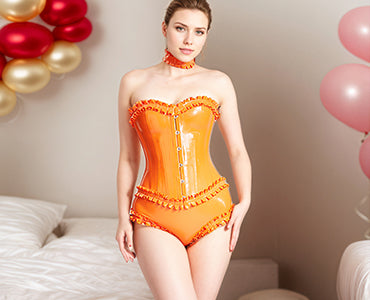Latex vs. Vinyl Clothing: A Connoisseur's Guide
In the world of high-gloss fashion, two materials reign supreme: latex and vinyl. To the untrained eye, they might seem similar, but as an enthusiast, you know the truth. They are worlds apart.
While vinyl (or PVC) offers an accessible shine, what makes it fundamentally different from the "second-skin" experience of latex that you know and love? This guide is for the true latex connoisseur. We'll dive deep into the sensory, material, and practical differences between latex and vinyl.

The Soul of the Material: What is Latex?
A Natural, Organic Origin
Latex is not plastic; it's a natural, organic material with a unique origin. It is derived directly from the sap of the Hevea brasiliensis, or rubber tree. For many enthusiasts, this connection to a "living" material is a core part of its appeal, setting it worlds apart from mass-produced synthetics.
The Second-Skin Experience
The feel of latex is also unique because it's a solid sheet of rubber, not a fabric. It is 100% material, inside and out. This construction is precisely why it clings and molds to every curve of the body, creating a true "second-skin" experience that simply "wearing" a garment cannot replicate.
What is Vinyl (PVC)?
A Man-Made Synthetic
Vinyl, which you'll often see labeled as PVC (Polyvinyl Chloride), is a man-made synthetic. It's a petroleum-based plastic product. This places it in a completely different material category from natural latex, and that difference is the source of all its other distinctions.
Fabric-Backed Construction
The most important difference in construction is that vinyl clothing is not a solid sheet. It is a layer of plastic (PVC) coating that is applied to a fabric backing, typically polyester. This immediately explains why it can never offer a true second-skin feel. When you wear vinyl, you are, in effect, wearing a plastic-coated fabric.
Latex vs. Vinyl
The Feel: Second Skin vs. Wearing a Garment
The sensory experience is where the two materials truly diverge. Latex feels smooth, soft, and gradually warms against the skin. It has a unique "swoosh" sound when it moves and a distinct, natural rubber scent that many find appealing. It truly changes the sensation of touch. Vinyl, on the other hand, is defined by its fabric backing. The inside feels like fabric, while the outside is often stiffer, cooler to the touch, and can be "crinkly" or "squeaky." It doesn't mold to the body's warmth and shape in the same way.
The Fit: Glued Perfection vs. Stitched Seams
How a garment is constructed dictates its fit. Latex garments are meticulously constructed by gluing the seams. This is a highly-skilled, artisanal process that creates flat, bonded edges. These seams move seamlessly with the material, allowing for an unparalleled, sculpted fit that follows every line of the body. Vinyl garments are sewn with a needle and thread, just like any regular fabric. This process creates bulkier, stitched seams that can pucker and interrupt the smooth line. More importantly, these threads and needle holes cannot stretch, which limits movement and can create weak points.
The Shine: An "Earned" Luster vs. an "Inherent" Glare
Even the shine is different. Latex naturally comes in a matte, dull state. That famous high-gloss shine is an earned reward. It's the result of a ritual, polishing the garment with silicone that you lovingly apply. The end product is a deep, liquid luster that moves with the light and the body. Vinyl is inherently shiny because it's plastic. Its "wet-look" is bright and immediate, but it's static. It doesn't have the same depth, richness, or personal connection.
The Stretch: All-Way vs. Two-Way
Latex has an incredible, all-way stretch, much like a balloon. It stretches with you in every direction, creating a comfortable compression and a perfect, form-hugging fit that adapts to your movement. Vinyl has very limited stretch, if any. You may see "stretch vinyl," but in those cases, it's the fabric backing that stretches, not the plastic coating. This can put stress on the plastic layer, which can lead to peeling or cracking at stress points over time.
The Enthusiast's Ritual: Comparing Care & Maintenance
The "con" of latex care is often a "pro" for enthusiasts.
Caring for Latex (The Ritual)
For the true enthusiast, the care process is part of the appeal. Caring for latex is a loving, multi-step process. It requires washing with mild soap after wear, drying it meticulously (away from all sunlight!), and storing it properly, often with talcum powder for preservation or a light layer of silicone for shine. This "ritual" is part of the ownership experience. It's a hands-on way to connect with your garments and ensure they are kept pristine.
Caring for Vinyl (The Wipe-Down)
Caring for vinyl is comparatively simple. Since it's plastic, you can just wipe it clean with a damp cloth. While this is certainly easier, it lacks that "hands-on" connection. Vinyl is also prone to its own set of issues. The plastic coating can peel or crack over time, and the inner fabric backing can absorb sweat and odors, making it difficult to truly clean.
The Connoisseur's Choice
Vinyl is a fun, affordable, and accessible way to get a shiny look. It certainly has its place.
But for the true connoisseur, vinyl can never replace latex. It cannot replicate the feel of a second skin, the fit of a garment glued perfectly to your body, or the experience of a natural material that warms your body.
Latex isn't just an outfit; it's an experience. Vinyl is just a shiny coat to most. Explore authentic latex fashion pieces that deliver the true second-skin experience. Discover our latex collection today at LatexBuy.

Latex vs. Vinyl FAQ
Is vinyl the same as latex?
No. Latex is a natural rubber. Vinyl (PVC) is a synthetic plastic-coated fabric.
How can I tell if clothing is latex or vinyl?
Look for the seams. If they are stitched with thread, it's vinyl. If they are flat and glued, it's latex. You can also check the inside. Vinyl will have a fabric backing, while latex will be smooth rubber on both sides.
Why is latex clothing so expensive compared to vinyl?
Latex is more expensive for two main reasons: the niche material (latex sheeting) and the highly skilled, time-consuming, manual labor required to construct garments by gluing seams by hand. Vinyl is mass-produced and machine-sewn.
Can I be allergic to vinyl?
Latex allergies are well-known. A true vinyl (PVC) allergy is rare, but some people can be sensitive to the plasticizers (chemicals like phthalates) used to make the vinyl flexible.












